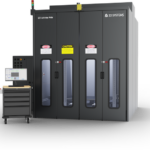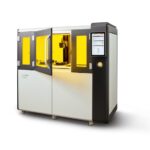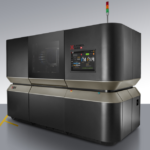Lithoz recently installed its new 3D printers at Dalhousie University in Nova Scotia, Canada. Both machines represent the leading edge of ceramic material development, each in its own way opening completely new dimensions in processing high-performance ceramics. They will also be the first of their kind on the North American continent, offering Dalhousie unique innovation advantages via the combination of these two printer’s specific strengths.

The CeraMax Vario V900, launched in 2022, features the innovative Laser-Induced Slipcasting (LIS) technology. LIS has been specifically designed to engineer large, thick-walled, and fully dense parts and enables the processing of dark ceramics such as silicon carbide — the material properties of which are highly desirable across many demanding applications under extreme conditions.
Dalhousie will use Lithoz LIS technology to greatly boost their research and development projects “on the dark side of ceramics,” namely silicon nitride, titanium carbide, and silicon carbide, and achieve further progress in industrial applications.
With carbide materials being typically very challenging to work with due to difficult processing via 3D printing and limited resolutions or defect-prone results using other processing technologies, LIS has been confirmed by Dalhousie to be the first 3D printing technology to achieve the necessary high resolutions and enable easier processing. With a simplified and speedy printing process, eliminating any need for debinding due to the use of standard industrial slurries, the parts can move straight from printing to sintering to allow for rapid and accurate ceramic part production. As the one technology currently able to produce sintered silicon carbide parts, LIS technology is a true game-changer for manufacturers looking to work with dark ceramics.
Alongside the CeraMax Vario V900, Dalhousie has purchased a Lithoz CeraFab Multi 2M30 to bring multi-material 3D printing into their portfolio. With the machine’s capability to combine ceramic and metal materials in a single layer and component, Dalhousie will look at incorporating electrical circuitry into ceramic components. The advancement of piezoceramics in this way will support the work of the HI-AM program, which works across Canada to overcome the obstacles facing the industrial adoption of metal additive manufacturing.
After receiving support through an award from the Canada Foundation for Innovation (CFI) Infrastructure Fund, Dalhousie’s $9 million funding proves the level of promise Lithoz technology shows for research and industry. Kevin Plucknett, Professor and I.W. Killam Memorial Research Chair at Dalhousie University is very excited to see the opportunities such an investment will bring to the region
“With the installation of two new Lithoz printers at our facilities, we are seeing the beginnings of a real 3D printing hotbed at Dalhousie,” said Plucknett. “By offering such state-of-the-art technology, researchers from across North America now have the chance to get in contact and work with Dalhousie using the technology that can really achieve their goals, while the active support and trainings provided by Lithoz as a partner will help us make the most of this process. We look forward to seeing how our 3D printing facilities can drive innovation throughout North America!”
Lithoz
lithoz.com
Dalhousie University
dal.ca
Canada Foundation for Innovation
innovation.ca







Leave a Reply
You must be logged in to post a comment.